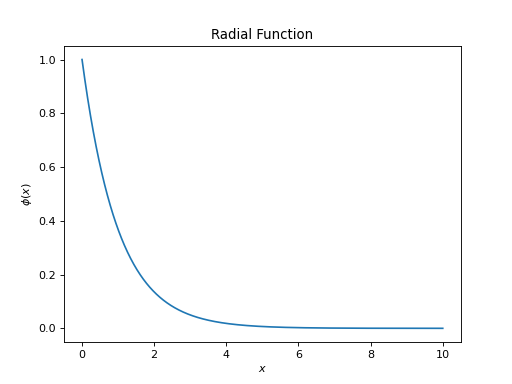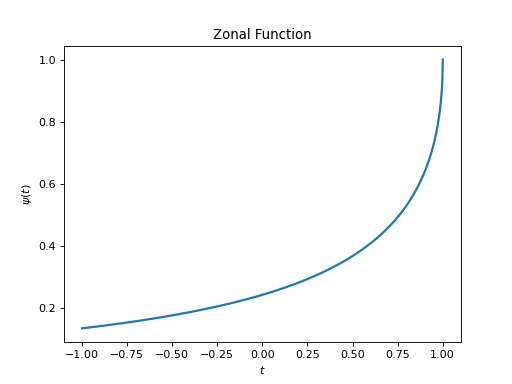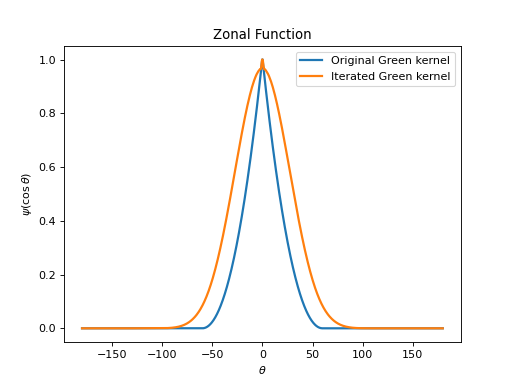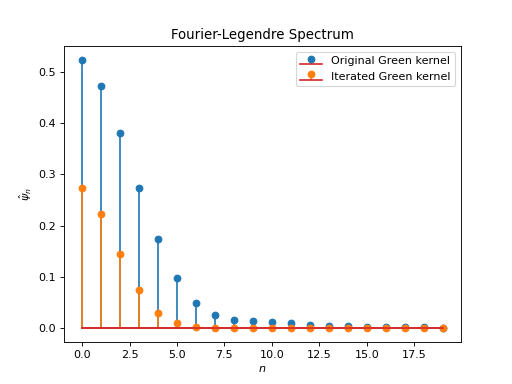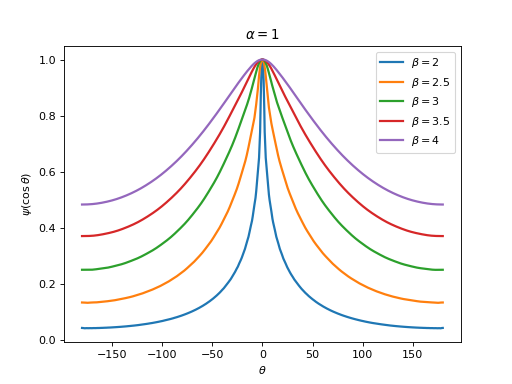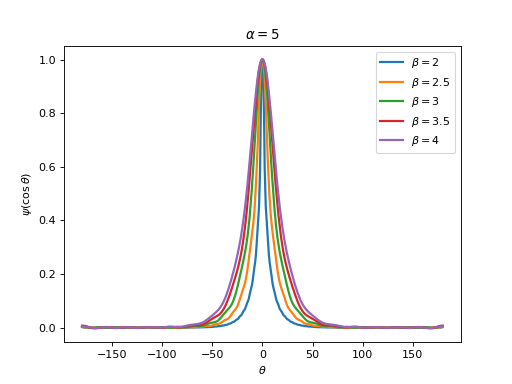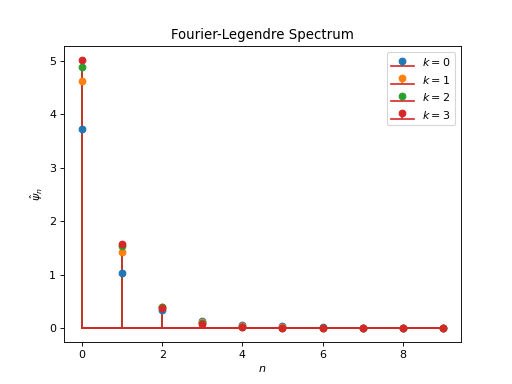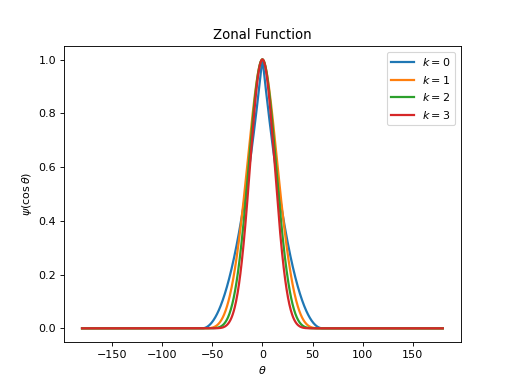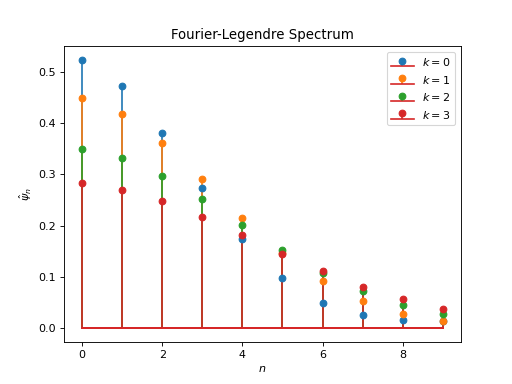Zonal Green Kernels¶
Module: pycsphere.green
Common zonal green kernels (see Chapter 4 of [FuncSphere] for a survey).
Abstract Classes
Truncated Fourier-Legendre series. |
|
|
Base class for zonal green functions. |
|
Transforms a radial Green function into a zonal Green kernel. |
|
Exponentiated zonal Green kernel. |
Implicit Zonal Green Kernels
|
Zonal Green kernel of the Sobolev operator \((\alpha^2\mbox{Id} -\Delta_{\mathbb{S}^2})^{\beta/2}\). |
|
Zonal Green kernel of the Fractional Laplace-Beltrami operator \((-\Delta_{\mathbb{S}^2})^{\beta/2}\). |
|
Zonal Green kernel of the iterated Laplace-Beltrami operator \(\Delta_{\mathbb{S}^2}^{k}\). |
|
Zonal Green kernel of the Beltrami operator \(\partial_k=k(k+1)\mbox{Id}+\Delta_{\mathbb{S}^2}\). |
|
Zonal Green kernel of the Beltrami operator \(\partial_{0\cdots k}=\partial_0\cdots\partial_k\). |
Explicit Zonal Green Kernels
|
Matern zonal Green kernel. |
|
Wendland zonal Green kernel. |
-
class
TruncatedFourierLegendreSeries(fn: numpy.ndarray)[source]¶ Bases:
objectTruncated Fourier-Legendre series.
Given coefficients \(\{\hat{f}_n, n=0,\ldots, N\}\), compute the truncated Fourier-Legendre series:
\[f_N(t):=\sum_{n=0}^N \hat{f}_n \frac{2n+1}{4\pi} P_n(t), \quad \forall t\in [-1,1].\]Examples
import numpy as np from pycsphere.green import TruncatedFourierLegendreSeries n_max=20 n=np.arange(0, n_max + 1).astype(np.float) fn=0*n; fn[n>0]=(n[n>0]*(n[n>0]+1))**(-1) fN=TruncatedFourierLegendreSeries(fn) theta=np.linspace(-np.pi, np.pi, 1024) plt.plot(theta, fN(np.cos(theta))) plt.ylabel('$f_N(\\cos\\theta)$') plt.xlabel('$\\theta\\in[-\\pi,\\pi]$')
(Source code, png, hires.png, pdf)
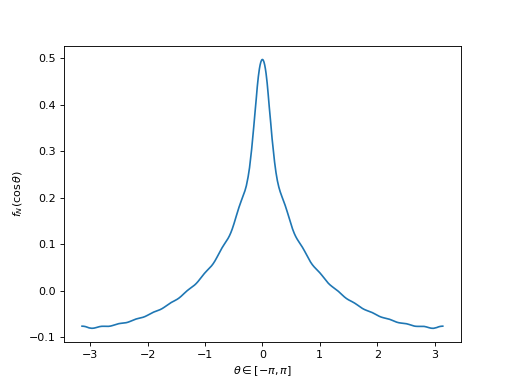
Notes
The
TruncatedFourierLegendreSeriesis computed by interpolating linearly the result ofFourierLegendreTransform.
-
class
ZonalGreenFunction(order: Optional[float] = None, rtol: float = 0.0001, cutoff: Optional[int] = None)[source]¶ Bases:
abc.ABCBase class for zonal green functions.
Any subclass/instance of this class must implement the abstract method
_compute_fl_coefficients.Notes
Consider a spherical pseudpo-differential operator acting on a spherical function \(h(\mathbf{r})\) as:
\[\mathcal{D} h:=\sum_{n=0}^{+\infty}\hat{D}_n \left[\sum_{m=-n}^{n}\hat{h}_n^m Y_n^m\right],\]where \(\{\hat{D}_n\}_{n\in\mathbb{N}}\in\mathbb{R}^\mathbb{N}\) is a sequence of real numbers such that the set
\[\mathcal{K}_\mathcal{D}:=\left\{n\in\mathbb{N}:\; \vert \hat{D}_n\vert=0\right\},\]is finite and
\[\vert\hat{D}_n\vert=\Theta\left(n^p\right),\]for some real number \(p\geq 0\), called the spectral growth order of \(\mathcal{D}\). Then, the zonal Green kernel of \(\mathcal{D}\) is given by Proposition 4 of [FuncSphere]:
\[\psi_{\mathcal{D}}(\langle\mathbf{r}, \mathbf{s}\rangle) := \sum_{{n\in\mathbb{N}\backslash\mathcal{K}_\mathcal{D}}} \frac{2n+1}{4\pi \hat{D}_n}P_{n}(\langle\mathbf{r}, \mathbf{s}\rangle),\quad \mathbf{r}\in\mathbb{S}^{2},\]where \(P_{n}\) are the Legendre polynomials. The summation above is truncated to a large enough \(N\) called the effective bandwidth of the zonal Green kernel.
-
__init__(order: Optional[float] = None, rtol: float = 0.0001, cutoff: Optional[int] = None)[source]¶
-
get_cutoff(min_cutoff: int = 16) → int[source]¶ Compute the effective bandwidth of the zonal Green kernel.
-
green_kernel() → Callable[source]¶ Compute the zonal Green kernel.
- Returns
The zonal Green kernel as a callable function.
- Return type
Callable
-
plot(resolution: int = 1024, color: str = None, linewidth: Union[int, float] = 2, angles: bool = False, fraction: float = 1, fhandle: Optional[Any] = None)[source]¶ Plot the zonal Green kernel.
- Parameters
resolution (int) – Resolution of the uniform grid on which the Green kernel is sampled.
color (str) – Color of the line.
angles (bool) – If
Trueplot \(\psi(\cos(\theta))\), otherwise plot \(\psi(t)\).fraction (float) – Plot over
[-fraction, fraction](ifangles==False) or[-np.pi*fraction, np.pi*fraction](ifangles==True) with0<fraction<=1.fhandle (Optional[Any]) – Figure handle in which to plot.
-
-
class
Radial2Zonal(radial_green: Callable, order: Optional[float] = None, rtol: float = 0.0001, cutoff: Optional[int] = None)[source]¶ Bases:
pycsphere.green.ZonalGreenFunctionTransforms a radial Green function into a zonal Green kernel.
Let \(\phi:\mathbb{R}_+\to \mathbb{C}\) be a radial function. The zonal Green kernel associated to \(\phi\) is defined as:
\[\psi(t):=\phi(\sqrt{2-2t}), \qquad t\in [-1,1].\]Examples
from pycsphere.green import Radial2Zonal from pycsou.math import Matern radial_green=Matern(k=0, epsilon=1) zonal_green=Radial2Zonal(radial_green=radial_green, order=3 / 2) plt.plot(np.linspace(0,10,1024), radial_green(np.linspace(0,10,1024))) plt.xlabel('$x$') plt.ylabel('$\\phi(x)$') plt.title('Radial Function') zonal_green.plot() zonal_green.spectrum(n_max=20)
-
__init__(radial_green: Callable, order: Optional[float] = None, rtol: float = 0.0001, cutoff: Optional[int] = None)[source]¶ - Parameters
radial_green (Callable) – Radial green function (must have a method
__call__for evaluation).order (Optional[float]) – Spectral growth order of the associated pseudo-differential operator.
rtol (float) – Threshold for defining the effective bandwidth of the zonal Green kernel.
cutoff (Optional[int]) – Effective bandwidth of the zonal Green kernel.
-
-
class
ZonalGreenExponentiated(base_green_kernel: pycsphere.green.ZonalGreenFunction, exponent: int, rtol: float = 0.0001, cutoff: Optional[int] = None)[source]¶ Bases:
pycsphere.green.ZonalGreenFunctionExponentiated zonal Green kernel.
Consider a zonal Green kernel \(\psi:[-1,1]\to \mathbb{C}\) with Fourier-Legendre expansion:
\[\psi(t)=\sum_{n=0}^{+\infty}\frac{2n+1}{4\pi\hat{D}_n} P_n(t), \quad t\in[-1,1].\]Then, the exponentiated zonal Green kernel \(\psi^{(\alpha)}:[-1,1]\to \mathbb{C}, \; \alpha\in\mathbb{R}_+\) has Fourier-Legendre expansion:
\[\psi^{(\alpha)}(t)=\sum_{n=0}^{+\infty}\frac{2n+1}{4\pi\hat{D}^\alpha_n} P_n(t), \quad t\in[-1,1].\]Examples
from pycsphere.green import ZonalWendland, ZonalGreenExponentiated zonal_green=ZonalWendland(k=0) iterated_zonal_green=ZonalGreenExponentiated(zonal_green, exponent=2) zonal_green.plot(angles=True, fhandle=1) iterated_zonal_green.plot(angles=True, fhandle=1) plt.legend(['Original Green kernel', 'Iterated Green kernel']) zonal_green.spectrum(n_max=20, fhandle=2, color_index=0) iterated_zonal_green.spectrum(n_max=20, fhandle=2, color_index=1) plt.legend(['Original Green kernel', 'Iterated Green kernel'])
-
__init__(base_green_kernel: pycsphere.green.ZonalGreenFunction, exponent: int, rtol: float = 0.0001, cutoff: Optional[int] = None)[source]¶ - Parameters
base_green_kernel (ZonalGreenFunction) – Zonal Green kernel to be exponentiated.
exponent (int) – Exponent \(\alpha>0\).
rtol (float) – Threshold for defining the effective bandwidth of the zonal Green kernel.
cutoff (Optional[int]) – Effective bandwidth of the zonal Green kernel.
-
-
class
ZonalGreenSobolev(alpha: Union[float, int], exponent: Union[int, float], rtol: float = 0.0001, cutoff: Optional[int] = None)[source]¶ Bases:
pycsphere.green.ZonalGreenFunctionZonal Green kernel of the Sobolev operator \((\alpha^2\mbox{Id} -\Delta_{\mathbb{S}^2})^{\beta/2}\).
Examples
from pycsphere.green import ZonalGreenSobolev for exp in [2,2.5,3,3.5,4]: zonal_green=ZonalGreenSobolev(alpha=1., exponent=exp) zonal_green.plot(angles=True, fhandle=1) plt.legend([f'$\\beta={np.round(val, 1)}$' for val in [2,2.5,3,3.5,4]]) plt.title('$\\alpha=1$') for exp in [2,2.5,3,3.5,4]: zonal_green=ZonalGreenSobolev(alpha=5., exponent=exp) zonal_green.plot(angles=True, fhandle=2) plt.legend([f'$\\beta={np.round(val, 1)}$' for val in [2,2.5,3,3.5,4]]) plt.title('$\\alpha=5$')
Notes
We have in this case \(\hat{D}_n=(\alpha^2+n(n+1))^{\beta/2},\) \(\hat{D}_n>0\), \(|\hat{D}_n|=\Theta(n^{\beta})\), and \(\mathcal{K}_{\mathcal{D}}=\emptyset\).
-
__init__(alpha: Union[float, int], exponent: Union[int, float], rtol: float = 0.0001, cutoff: Optional[int] = None)[source]¶ - Parameters
-
-
class
ZonalGreenFractionalLaplaceBeltrami(exponent: float, rtol: float = 0.0001, cutoff: Optional[int] = None)[source]¶ Bases:
pycsphere.green.ZonalGreenSobolevZonal Green kernel of the Fractional Laplace-Beltrami operator \((-\Delta_{\mathbb{S}^2})^{\beta/2}\).
Examples
from pycsphere.green import ZonalGreenFractionalLaplaceBeltrami for exp in [2,2.5,3,3.5,4]: zonal_green=ZonalGreenFractionalLaplaceBeltrami(exponent=exp) zonal_green.plot(angles=True, fhandle=1) plt.legend([f'$\\beta={np.round(val, 1)}$' for val in [2,2.5,3,3.5,4]])
(Source code, png, hires.png, pdf)
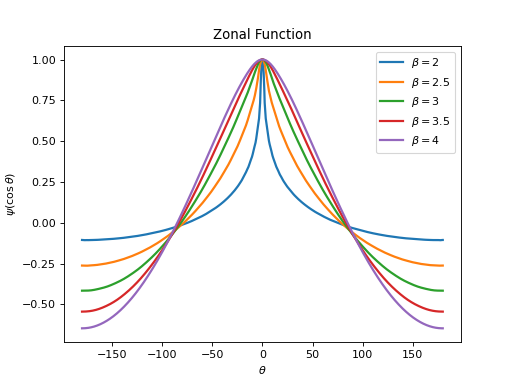
Notes
We have in this case \(\hat{D}_n=(n(n+1))^{\beta/2},\) \(\hat{D}_n\geq 0\), \(|\hat{D}_n|=\Theta(n^{\beta})\), and \(\mathcal{K}_{\mathcal{D}}=\{0\}\). See Example 4.2 of [FuncSphere] for a closed-form formula of the zonal Green kernel for \(\beta=4\). The case \(\beta=1\) yields the square-root of the Laplace-Beltrami operator, which is intimately linked to the spherical divergence and gradient differential operators.
See also
-
class
ZonalGreenIteratedLaplaceBeltrami(exponent: int, rtol: float = 0.0001, cutoff: Optional[int] = None)[source]¶ Bases:
pycsphere.green.ZonalGreenFunctionZonal Green kernel of the iterated Laplace-Beltrami operator \(\Delta_{\mathbb{S}^2}^{k}\).
Examples
from pycsphere.green import ZonalGreenIteratedLaplaceBeltrami for exp in [1,2,3,4,5]: zonal_green=ZonalGreenIteratedLaplaceBeltrami(exponent=exp) zonal_green.plot(angles=True, fhandle=1) plt.legend([f'$k={np.round(val, 1)}$' for val in [1,2,3,4,5]])
(Source code, png, hires.png, pdf)
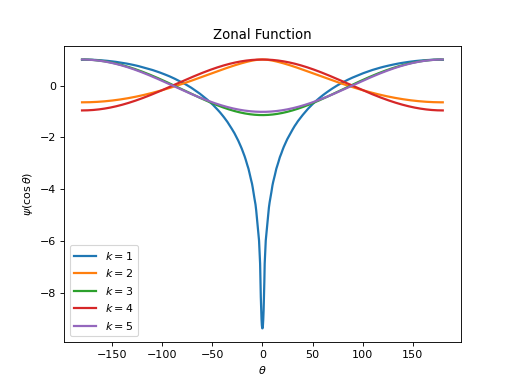
Notes
We have in this case \(\hat{D}_n=(-n(n+1))^{k},\) \(\hat{D}_n\in \mathbb{R}\), \(|\hat{D}_n|=\Theta(n^{2k})\), and \(\mathcal{K}_{\mathcal{D}}=\{0\}\). See Example 4.2 of [FuncSphere] for a closed-form formula of the zonal Green kernel for \(k=2\).
See also
-
class
ZonalGreenBeltrami(k: int, rtol: float = 0.0001, cutoff: Optional[int] = None)[source]¶ Bases:
pycsphere.green.ZonalGreenFunctionZonal Green kernel of the Beltrami operator \(\partial_k=k(k+1)\mbox{Id}+\Delta_{\mathbb{S}^2}\).
Examples
from pycsphere.green import ZonalGreenBeltrami for k in [1,2,3,4,5]: zonal_green=ZonalGreenBeltrami(k=k) zonal_green.plot(angles=True, fhandle=1) plt.legend([f'$k={np.round(val, 1)}$' for val in [1,2,3,4,5]])
(Source code, png, hires.png, pdf)
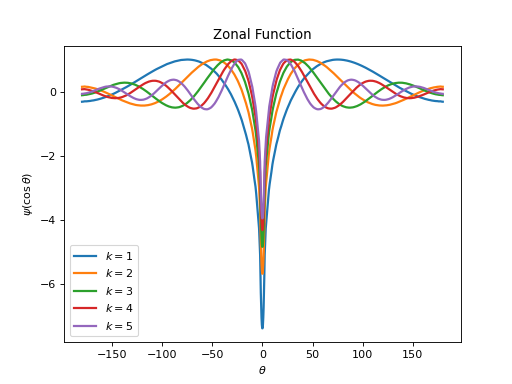
Notes
We have in this case \(\hat{D}_n=k(k+1)-n(n+1),\) \(\hat{D}_n\in \mathbb{R}\), \(|\hat{D}_n|=\Theta(n^{2})\), and \(\mathcal{K}_{\mathcal{D}}=\{k\}\). See Chapter 4 of [FuncSphere] for properties of Beltrami operators.
See also
-
class
ZonalGreenIteratedBeltrami(k: int, rtol: float = 0.0001, cutoff: Optional[int] = None)[source]¶ Bases:
pycsphere.green.ZonalGreenFunctionZonal Green kernel of the Beltrami operator \(\partial_{0\cdots k}=\partial_0\cdots\partial_k\).
Examples
from pycsphere.green import ZonalGreenIteratedBeltrami for k in [1,2,3,4,5]: zonal_green=ZonalGreenIteratedBeltrami(k=k) zonal_green.plot(angles=True, fhandle=1) plt.legend([f'$k={np.round(val, 1)}$' for val in [1,2,3,4,5]])
(Source code, png, hires.png, pdf)
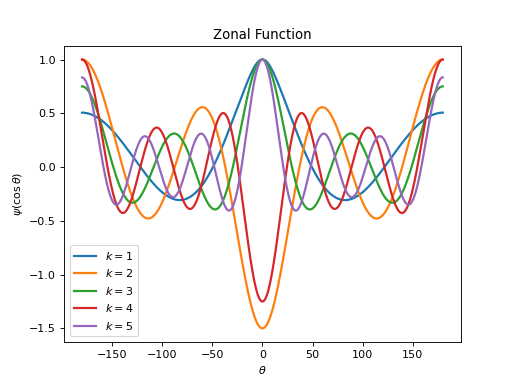
Notes
We have in this case \(\hat{D}_n=\Pi_{j=0}^k j(j+1)-n(n+1),\) \(\hat{D}_n\in \mathbb{R}\), \(|\hat{D}_n|=\Theta(n^{2(k+1)})\), and \(\mathcal{K}_{\mathcal{D}}=\{0,\ldots,k\}\). See Chapter 4 of [FuncSphere] for properties of Beltrami operators.
See also
-
class
ZonalMatern(k: int, epsilon: float = 1.0, rtol: float = 0.0001, cutoff: Optional[int] = None)[source]¶ Bases:
pycsphere.green.Radial2ZonalMatern zonal Green kernel.
The Matern zonal Green kernel is obtained by restricting the radial Matern function
pycsou.math.green.Maternto the sphere as described inpycsphere.green.Radial2Zonal.Examples
from pycsphere.green import ZonalMatern for k in [0, 1,2,3]: zonal_green=ZonalMatern(k=k) zonal_green.plot(angles=True, fhandle=1) plt.legend([f'$k={np.round(val, 1)}$' for val in [0, 1,2,3]]) for k in [0, 1,2,3]: zonal_green=ZonalMatern(k=k) zonal_green.spectrum(n_max=10, fhandle=2, color_index=k) plt.legend([f'$k={np.round(val, 1)}$' for val in [0, 1,2,3]])
Notes
See Chapter 8 of [FuncSphere] for definitions, closed-form formulas and properties.
See also
pycsou.math.green.Matern,Wendland-
__init__(k: int, epsilon: float = 1.0, rtol: float = 0.0001, cutoff: Optional[int] = None)[source]¶ - Parameters
Notes
See the help of
pycsou.math.green.Maternfor more details on the parameterskandepsilon.
-
-
class
ZonalWendland(k: int, epsilon: float = 1.0, rtol: float = 0.0001, cutoff: Optional[int] = None)[source]¶ Bases:
pycsphere.green.Radial2ZonalWendland zonal Green kernel.
The Wendland zonal Green kernel is obtained by restricting the radial Wendland function
pycsou.math.green.Wendlandto the sphere as described inpycsphere.green.Radial2Zonal.Examples
from pycsphere.green import ZonalWendland for k in [0, 1,2,3]: zonal_green=ZonalWendland(k=k) zonal_green.plot(angles=True, fhandle=1) plt.legend([f'$k={np.round(val, 1)}$' for val in [0, 1,2,3]]) for k in [0, 1,2,3]: zonal_green=ZonalWendland(k=k) zonal_green.spectrum(n_max=10, fhandle=2, color_index=k) plt.legend([f'$k={np.round(val, 1)}$' for val in [0, 1,2,3]])
Notes
See Chapter 8 of [FuncSphere] for definitions, closed-form formulas and properties.
See also
pycsou.math.green.Wendland,Matern-
__init__(k: int, epsilon: float = 1.0, rtol: float = 0.0001, cutoff: Optional[int] = None)[source]¶ - Parameters
Notes
See the help of
pycsou.math.green.Wendlandfor more details on the parameterskandepsilon.
-
